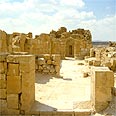
Preserving world's biblical heritage
Israel hopes UNESCO selection of ancient archeological areas as world heritage sites will encourage international tourism
The biblical archaeological sites of Tel Megiddo, Hazor, Beer Sheva, and Spice Route as well as the desert cities of Ovdat, Shavta, Halutza and Mamsheet were chosen this year.
They join the other three Israeli world heritage sites of Masada, the Old City of Acre, and the “White City” (Bauhaus and international design) in Tel Aviv.
Preserving world heritage
UNESCO is the educational, scientific and cultural arm of the United Nations, and the designation of world heritage sites around the world is one of the most important of the organization’s missions.
UNESCO identifies and designates sites around the world that are deemed important to preserve because of their importance to the history and heritage of all of mankind.
Designating a place a world heritage site lends it greater international appreciation and makes it a magnet for tourists worldwide. The choice also requires the country in which the site is located to be responsible for its preservation and safeguarding for the generations to come.
To date, there are 812 world heritage sites around the world.
The selected sites in Israel are under the auspices of the Nature Reserve and Parks Authority, which is responsible for the care and upkeep of the site.
Submission process
But it is the Israel World Heritage Committee, led by Professor Mike Turner that decides each year which sites will be submitted to UNESCO for consideration. The process of submitting a site for approval is a lengthy one and can go on for two to three years.
The committee is made up from, among others, representatives of the Education, Foreign and Tourism Ministries; the Antiquities Authority, Nature Reserve and Parks Authority, and Government Tourism Office.
Once the committee decides which sites to submit, UNESCO deliberates over which one gets the nod.
Last year for example, the Spice Route was rejected by the organization for lack of information. This year Israel was lauded for the information it added to the file and was rewarded in kind.
The Tels
The hilltop ruins or "tels," as they are called in Hebrew, of Megiddo and Hazor are excellent examples of biblical Israelite cities.
Both are mentioned in the Bible several times and have been carefully excavated. The Tels have yielded many treasures that shed light on the history of the different nations that inhabited the Land of Israel in biblical time, and in particular about the Kingdoms of Judah and Israel.
The archaeological digs of the Tels reveal meticulously planned cities protected by enormous fortress walls with impressive gates, castles, temples, storage rooms, stables and water cisterns.
These biblical Tels help one understand the human values and how they developed in the Near East as they were influenced by Egyptian civilization and ancient Hellenistic culture.
The Tels are a testimony to a lost civilization from the Bronze Age, and are able to bring the biblical stories of the nation to life in a tangible way.
The Spice Route and the desert towns of the Negev
Spices and religious, social and cultural artifacts were carried along the Spice Route from Yemen via Saudi Arabia and Jordan through the Negev to the Mediterranean Sea and, then from there, to Europe.
The route extends some 2,400 kilometers (about 1500 miles) and it was used to transport mainly incense like Levona and Myrrh, along with other spices, jewelry, gold, silver and expensive fabrics. The route was used from the 3rd-century B.C.E. until at least the 3rd century C.E.
The most impressive part of the route cuts through the Negev on a diagonal, from the area of Zofar in the Arava until Ovdat in the lower south.
Throughout this segment of the Spice Route, many impressive remains of it have been found including campgrounds, water reservoirs, public baths, guard towers, ritual altars, signs of road clearing and even shoulders of the route that have been marked off by stones.
The ancient cities of Mamsheet, Shavta, Ovdat and Halutza were found along this section of the route.
Good for Israel
Limor Livnat, Education Minister and also president of UNESCO in Israel said that the selection is an unprecedented achievement for Israel.
The Nature Reserve and Parks Authority will be conducting free guided tours of the biblical Tels of Megiddo, Hazor, Beer Sheva and Ovdat this coming Saturday, the 23rd of July. Tours are scheduled for 11:00 a.m., 1:00 p.m. and 3:00 p.m.
For more information, call the Authority’s toll free number at *3639.











